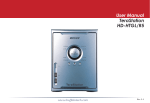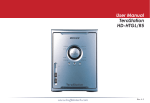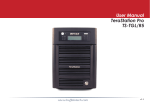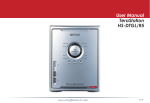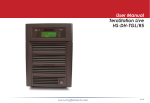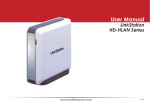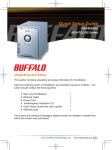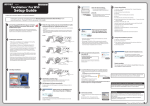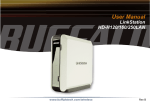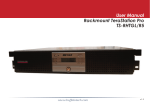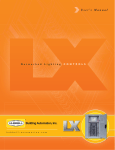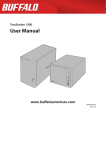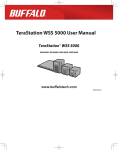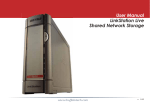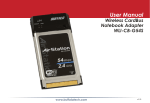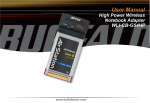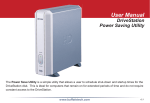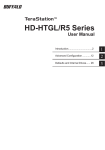Download User Manual
Transcript
User Manual TeraStation HD-HTGL/R5 www.buffalotech.com/wireless Rev B Introduction User Manual Congratulations on your new TeraStation! This user manual is intended to assist you in configuring it. If you run into difficulties or need additional help, feel free to contact our 24/7 Technical Support at 1(866) 752-6210 (USA & Canada only). This user manual uses images representative of TeraStation user interfaces and software. Because we’re constantly updating our product, the images and text in this manual may vary slightly from the images and text displayed by your TeraStation. These changes are minor and should not affect the ease of setup adversely. As time passes, future user interfaces, updated software, and later versions of this manual may be freely available for download at our web site: http://www.buffalotech.com/support. 2 Table of Contents Table of Contents TeraStation Quick Setup ................................... 4 TeraNavigator Setup ......................................... 8 Accessing TeraStation Data from PC ............. 14 TeraStation Diagram ....................................... 18 Advanced Settings .......................................... 21 Basic Settings ................................................. 22 Network Settings ............................................ 23 Disk Management ........................................... 25 Adding Extra Hard Drives ............................... 31 Shared Folders ................................................ 35 Groups ............................................................. 39 Users ............................................................... 40 Printers ................................. .......................... 42 Backups .......................................... ................ 46 PCast .......................................... .................... 50 Maintenance Settings ..................................... 51 UPS Settings ................................................... 52 Client Utility .................................................... 61 Troubleshooting .............................................. 63 Technical Specifications................................. 64 Technical Support ........................................... 65 3 TeraStation Quick Setup Basic Setup Begin setting up your TeraStation by plugging your power cable and Ethernet cable into the back of the TeraStation as shown. 4 TeraStation Quick Setup Connect your cables Plug the power cord into a 120 volt wall socket. Plug the other end of the Ethernet cable into a hub, router, or switch in your network. 5 TeraStation Quick Setup Make sure that the power switch on the rear of the TeraStation is in the ON position, with the “I” symbol pressed down. Press the power button on the front panel. The LED’s will swirl as your TeraStation boots up. After your TeraStation has completed booting up and the LED’s have ceased to swirl, check the LINK/ACT LED on the front of the TeraStation. If it’s lit, then your TeraStation is connected properly, and you can go on to page 8. If it’s not lit, turn to page 7 for troubleshooting. 6 TeraStation Quick Setup Having problems? The TeraStation’s Ethernet port will automatically adjust to use either a Crossover or Patch cable, so you may connect the TeraStation to your network with either type of Ethernet cable. Buffalo Technology doesn’t recommend connecting the TeraStation directly to a PC. Verify that the LINK/ACT LED on the front of TeraStation is lit (see page 6’s picture). If it’s lit, go to page 8 to continue setting up TeraStation. If the LINK/ACT LED is still not lit, try the suggestions below to verify that you’re not suffering from common setup problems. Having problems? Make sure that: ● the TeraStation and the router, hub or switch are both powered on, ● the Ethernet cable is securely plugged in at both ends, and ● the Ethernet cable is not damaged. Verify this by trying a different Ethernet cable. If problems persist, contact our 24/7 technical support at 1(866) 752-6210. 7 TeraNavigator Setup Setting up TeraNavigator Insert the TeraNavigator CD into your PC’s CD-ROM drive. Setup should automatically launch. If it does not, manually launch setup.exe by pressing the Start menu and selecting the Run... option. When the Run dialog opens, type d:\setup.exe (where d is the drive letter of your CD-ROM drive). Press OK to continue. 8 TeraNavigator Setup TeraNavigator is now running. Please press the Install Client Utility icon, and then Start. When installation is finished, press Launch. 9 TeraNavigator Setup The TeraStation Client Utility allows you to easily configure TeraStation’s network settings. The tabs show the names of available TeraStations. If you have more than one TeraStation on the network, click the tab of the one you want to select it. While a TeraStation’s tab is selected, its IP Address is visible and the View Shares button will take you directly to its network shares and folders. See page 61 for more information on TeraStation Client Utility. For now, make sure that the proper TeraStation’s tab is selected, click Setup, and choose Browser Management. 10 TeraNavigator Setup This login prompt will appear. Enter admin for the user name. Until you change it, the password for the admin account will be password. Press the OK button when finished. User name: admin Password: password See page 41 to change your password. If you’ve forgotten your password, see page 51. If this login prompt does not appear, your DHCP server may not be functioning correctly. If DHCP is disabled, you may reenable it, or verify that the TeraStation’s IP address (page 10) is in the same range as that of your PC. See page 61 and page 62 to manually configure your TeraStation’s IP address if necessary. 11 TeraNavigator Setup You are now logged in to the TeraStation Management Utility. Bookmark this page in your browser so it can be easily accessed for future configuration changes. You can also get here by typing http://TERASTATION_ NAME into a Web browser, where TERASTATION_NAME is the name of your TeraStation that you set on page 13. For detailed explanations of each menu and setting, please refer to the Advanced Settings section (starting on page 21) of this manual. To continue setup, click on the Basic link on the left side. 12 TeraNavigator Setup Here on the Basic page, begin by changing the name of your TeraStation in the TeraStation Hostname field. A friendly, easy-to-remember name is recommended. The name cannot contain any spaces or special characters. Alphanumeric characters, hyphens, and underscores are allowed. A short description of the TeraStation can be entered into the TeraStation Description field. You’ll then see this description in Network Neighborhood on Windows machines. Make sure that the date and time are correct in Date and Time Setup. To synchronize clock settings with your computer, press Use Local Time. Once desired fields have been completed, press the Apply button at the bottom of the page. For more information on the Configuration Utility, turn to Advanced Settings, beginning on page 21. 13 TeraNavigator Setup Congratulations! You’ve completed basic setup. For more detail on the other settings available in your TeraStation, turn to Advanced Settings, beginning on page 21. To access TeraStation data: Press the Start menu, select the Run... option. When the Run dialog opens, type \\TeraStation_Name (where ‘TeraStation_Name” is the TeraStation Hostname set on page 13). Press the OK button to continue. 14 Accessing TeraStation Data from a PC TeraStation’s root directory will appear. You will see all of the configured shares, including share, the preconfigured data folder. All users can read and write to all folders unless otherwise configured. To set up security and password protection, or add other shares to your TeraStation, please refer to pages 35 - 37 of this manual. To change your RAID configuration, see pages 26 - 29. To setup a printer see the Printers section beginning on page 42. Drive letters can also be mapped to shares on your TeraStation; see page 16 for more information. Note: If this page does not appear, or if you receive a popup window from your firewall saying that a NetBios Session has been blocked from your TeraStation’s IP address, you will need to add your TeraStation’s IP address to your firewall’s trusted zone. You can get your TeraStation’s IP address from the TeraStation Client Utility (see page 10). Consult your firewall documentation for more information on allowing network access to and from a specific IP address. 15 Accessing TeraStation Data from a PC From the TeraStation’s Root Directory screen (see page 15), click the Tools pull down menu and select Map Network Drive; Map Network Drive will run. Select the drive letter you would like to map from the Drive: pull down menu. Enter the \\TeraStation_Name\share_name in the Folder: field, where TeraStation_Name is the TeraStation Name set on page 13 and share_name is share (if you’re mapping to this preconfigured folder) or the name of another shared folder that you set up on page 22. You may browse for a shared folder by pressing the Browse button and searching through the Entire Network and then the Microsoft Windows Network. Check the Reconnect at logon checkbox to have Windows connect to this mapped drive everytime it starts. When finished, press the Finish button. TeraStation is now mapped to a drive letter. 16 TeraStation Expansion TeraStation Expansion Information TeraStation has four USB 2.0 ports, two on the front panel and two on the rear. These ports can be used for adding external USB Hard Drives or a USB Printer. TeraStation will then share the USB devices, allowing everyone on the network to use them. Up to four external USB hard drives, or one printer and three hard drives, may be added to TeraStation. To connect a USB printer or hard drive to TeraStation, simply plug it into one of the four USB Ports. USB Hard Drive Information: You may plug in additional USB hard drives to any of the four USB ports on your TeraStation. See page 31 for setting up your USB hard drive under TeraStation. See page 35 for information on setting up shared folders on a USB Hard Drive. Page 34 will show you how to reformat the USB Hard Drive. Page 46 shows you how to set up TeraStation to backup to a USB Hard Drive. USB Printer Information: See page 42 to set up a USB Printer as a network printer on TeraStation. 17 TeraStation Diagram 1. Power Button – Press and release the Power Button to turn the TeraStation on. Hold it down for 3 seconds to turn the TeraStation off. 2. USB Ports – USB ports on both front and rear panels of the TeraStation may be used to connect USB hard drives, a printer, or an additional TeraStation to your TeraStation. See TeraStation Expansion on page 17 for more information on using TeraStation’s USB ports. 3. Hard Drive Status (also 5, 8, and 10) – This LED will glow green when the corresponding hard drive is detected at boot, and will blink green when a disk check or format is in process. It will glow red when the hard drive is 90% full or more, and blink red if there is a problem with the drive. 4. Hard Drive Access (also 6, 7, and 9) – This LED will blink green when the associated hard drive is accessed. During startup, it’s normal for all the lights on the front panel to light up in order, producing a pinwheel effect. 18 TeraStation Diagram 11. Diagnostic LED – The Diagnostic LED may flash when the TeraStation encounters an error. In this event, please contact our 24/7 technical support at 1(866) 752-6210. 12. Power – This LED glows a steady green while the TeraStation is operating normally. It blinks quickly during bootup and shutdown, and slowly while the TeraStation is in sleep mode. 13. Link/Act – This LED will glow when the TeraStation is connected to a network, and blink during normal network activity. It changes color to indicate the speed of the connection: blue for a 1000Mbps connection, green for 100Mbps, and red for a 10Mbps connection. 14. Power Socket – Plug the power cord into this socket. 19 15. Power Switch – This is the TeraStation’s master power switch. While it is on, the power button on the front panel of the TeraStation may be used to start and shut down the unit. When this switch is off, no power goes to the unit. If this switch is left off for an extended period of time, the TeraStation’s internal system clock may need to be reset. 16. Internal Fan – The internal fan will adjust its speed according to the temperature inside the TeraStation. To prevent possible overheating, keep the fan clear and clean of obstacles or dust. 17. INIT Button – The INIT button restores your TeraStation to factory default settings. See page 51 for more information on using the INIT button. TeraStation Diagram 18. UPS interface – An Uninterruptable Power Supply can use this interface to safely shut down your TeraStation in the event of a power failure. This interface is non-LPS. DP-1, DP-1P, DP-2, or DP-2P cables may be used to connect to the UPS. 19. 10/100/100 Mbps Ethernet Port – Use this port to connect your TeraStation to a switch, a router, or another computer. The port is autosensing, so either a conventional Ethernet cable or a crossover Ethernet cable may be used. 20. USB Ports – TeraStation offers four USB 2.0/1.1 ports for adding external drives or USB printers. Please see the TeraStation Expansion section on page 17 to learn more about using TeraStation’s USB Ports. 20 Advanced Settings Browser Management Tool - Home Welcome to Advanced Settings! We’ll discuss the many adjustments you can make to your TeraStation. Begin by bringing up the Browser Management screen that you bookmarked on page 12. You are now at Home. Notice that Home is lit up in yellow in the screenshot to the left. You can return to this page at any time by clicking on Home from the menu at the left of your Browser Management screen. Here, you can see basic information about your TeraStation’s setup. Now, click the Basic link from the menu on the left side of your screen. 21 Advanced Settings Basic You may modify your TeraStation’s hostname and description under Hostname Setup. Make sure that the date and time are correct in Date and Time Setup. To synchronize time settings with those in your computer, press Use Local Time. To have your system time automatically set by an NTP server, enable NTP Server and enter an IP address for the NTP server. Ensure that both the Display Language and the Windows Client Language are set to languages that you’re comfortable with. If you need to access your TeraStation with FTP or AppleTalk, enable these protocols under Network Sharing Services. Once desired fields have been completed, press the Apply button. 22 Advanced Settings Network (IP Address Properties) In most networks, TeraStation will get its IP address automatically from a DHCP server. You may disable DHCP here. If DHCP is disabled and an IP address is not set manually, it will default to 192.168.11.150. The TeraStation’s IP Address, Subnet Mask, Default Gateway Address, and DNS Server address may all be entered manually under IP Address Properties. Ethernet Frame Size may also be set manually on this page. Click Apply after making any changes. 23 Advanced Settings Network (Workgroup/Domain) To make your TeraStation a member of a workgroup or domain, enter the appropriate information into the fields on this page and click Apply. If the TeraStation is to be part of a Windows Domain, the TeraStation should be added beforehand to the Domain Controller with a computer account in Server Manager. 24 Advanced Settings Disk Management (Drive Properties) This page shows the current properties of your hard drives and RAID Arrays. To change these settings, click on RAID Configuration at left. 25 Note on RAID Arrays TeraStation uses RAID (“Redundant Array of Independent Disks”) technology to control the four hard drives in your TeraStation. RAID may be configured several ways: RAID Spanning - All four drives are striped into one large drive, giving the maximum capacity for your TeraStation. RAID Spanning is fast and efficient, but has no redundancy. If one hard drive fails, all data on the TeraStation is lost. This is how your TeraStation is set up out of the box. RAID 1 (mirroring) - Hard drives (or spanned pairs of hard drives) are arranged in mirrored pairs. Each half of the pair reads and writes exactly the same data. This costs you half the total capacity of your TeraStation, but provides excellent redundancy. If a hard drive fails, the mirror continues to supply data, so you may work on normally. You may replace the damaged or defective drive at any time, and normal RAID 1 mirroring will then be automatically restored. RAID 5 (parity) - All drives in a RAID 5 array reserve part of their data space for parity information, allowing all data to be recovered if a single drive fails. The parity information takes up about one hard drive’s worth of space, so if you set up all four drives in the TeraStation as a RAID 5 array, your usable capacity will be about 3/4 of the total capacity of the TeraStation. RAID 5 is an excellent compromise between efficiency and security. If a single drive fails, no data is lost. After the damaged or defective drive is replaced, your TeraStation will automatically restore all data to the new drive and resume normal RAID 5 operation. Buffalo Technology recommends RAID 5 for its excellent balance of efficiency and security. 26 Advanced Settings Disk Management (RAID Configuration) This page shows your current RAID arrays. You may delete old arrays or create new ones by clicking on the underlined RAID Array # under RAID Array Configuration. You may also disable RAID Array Error Detection Response from this page. Normally, this is set to automatically shut down the RAID array when an error is detected. Though it is not recommended, you may disable that behavior by clicking Disable and then Apply under RAID Array Error Detection Response. Note that your TeraStation has four internal hard drives. Before creating a new RAID array, you may have to delete one or more pre-existing RAID Arrays to clear up the hard drives for your new one. This will destroy all data currently on the disks, so back up any important data before deleting RAID arrays. Whether you want to clear out an old array or create a new one, begin by clicking on the array’s underlined RAID Array #, under Name. 27 Advanced Settings Disk Management (RAID Configuration) A configured RAID array may be deleted by pushing the Delete RAID Array button. This will free up all hard drives listed under Disk Structure. To configure an unconfigured array, put checks next to the hard disks you want included in the array (under Disk Structure) and choose your RAID mode. Click Setup RAID Array when ready. It may take several minutes to complete setting up the RAID array. When it’s finished, a Disk Check will run. 28 Advanced Settings Disk Management (Disk Check) When RAID Configuration is done, you’ll see this screen. To configure a new array, click on RAID Array # and go back to the bottom of page 28. To setup shares turn to page 35. 29 Advanced Settings Disk Management (RAID Configuration) You’ll see this screen when your new RAID Array is completely configured. Click on Shared Folders and turn to page 35 to begin setting up shares on your TeraStation. 30 Advanced Settings Disk Management (USB Settings) If you’ve plugged an external USB hard drive into one of the USB ports on your TeraStation, you may set it up from this page. Click on its name under USB Disk Setup to begin. 31 Advanced Settings Disk Management (USB hard drive setup) From here you can see your USB hard drive’s setup information. If the hard drive’s information isn’t displayed properly, try restarting your USB hard drive and then restarting your TeraStation. Some USB hard drives must be reformatted from within TeraStation before they can be assigned shares. Press Format USB Disk, or choose Disk Format from the left-side menu, to begin reformatting your USB hard disk. Turn to page 34 for more information on reformatting disks. Turn to page 35 to set up shares on your USB hard drives. 32 Disk Management (Disk Check) To initiate a comprehensive disk check on a hard drive or array of drives, select the hard drive or array that you want to check from the Target Disk dropbox and click the Select Target button. A disk check on larger hard drives or arrays may take several hours. 33 Disk Management (Disk Format) To format a hard drive or array, select it from the Target Disk dropbox. Choose the file system desired from the File System dropbox (internal drives can only be formatted with XFS). Note that FAT32 has a 4 gigabyte file size limit. If you choose FAT32 for your file system, you will not be able to store files larger than 4 gigabytes on the drive. Buffalo Technology recommends the XFS file system. Press Select Target Disk when done. Depending on the size of the target hard disk or array, a Disk Format may take several hours to complete. 34 Advanced Settings Shared Folders To begin setting up shares on your TeraStation, select Shared Folders from the left side menu, and then click the Add button under Shared Folders Setup. 35 Advanced Settings Add a new Shared Folder To add a new shared folder, enter a name for it in the Shared Folder Name box and choose which Disk Space it will reside in. You may also choose which operating systems the share will support by putting the appropriate checks next to Shared Folder OS Support, and whether the share supports the Recycle Bin by putting a dot next to Enable or Disable. Enter a Shared Folder Description and a Remote Backup Password if you desire. Click the Apply button to build the new shared folder. 36 Advanced Settings Shared Folders (Access restrictions) To use Access Restrictions for a share, put a dot next to Enable. Highlight groups or users in the All Groups/Users column and use the left-pointing arrow buttons (located just to the left of each box) to move individual groups or users from the All Groups/ Users column to the Read Only box (if you want to give them read access only) or all the way to the Writable box, if you want to give them full access to the share. Right-pointing arrows will move highlighted users or groups back to the right. Click Apply when you have your groups and users in the appropriate boxes. To set up new groups and users, see pages 39 and 40. 37 Advanced Settings Shared Folders (Anonymous FTP Setup) To allow Anonymous FTP, choose Enable for Anonymous FTP Server. Select a folder to share from the Anonymous User Public Shared Folder (only one folder may be shared by anonymous FTP) and choose whether you want the share to be Writable, or Read Only. Click the Apply button to set up anonymous FTP. If FTP Server is disabled in the Basic window, this page will not be accessible. Anonymous FTP mode uses port 8021 (i.e. ftp://IP Address:8021). 38 Advanced Settings Group Management To Delete a group, put a check next to its name and click Delete. To add a group to your TeraStation, click Add. Add a name and a description to the Add New Group fields. Put checks next to each Member User that you want to be part of the group. Click Apply when your group is set up the way you want it. 39 Advanced Settings User Management TeraStation is preconfigured with two users, admin and guest, out of the box. The guest account allows network users login access so that they can clear the print que. It has no password. The admin and guest user accounts cannot be deleted. To delete any other user, put a check next to their name and click Delete. To add a new user, click Add. The Add New User dialog will appear. Enter a User Name, Password, and User Description for the new user and click the Apply button. If a user will be accessing the TeraStation from a Windows 95/98 computer, their password should be 15 characters or less. Mac users’s passwords should be 9 characters or less. 40 Advanced Settings User Management (changing passwords) To change an account’s password, click on the name of the account under User Settings. Note: if a user name and password are used to log into user’s windows computer or domain, the same user name and password should be used when creating the user’s account on the TeraStation, or problems accessing shared folders may occur. Enter the desired new password in both boxes and click Apply. 41 Advanced Settings Print Server (Settings) A USB printer, plugged into a USB port on either the front or the rear of your TeraStation, may be used as a Windows Print Server and/or an Apple Print Server on your network by choosing Enable on this page as appropriate and then clicking Apply. 42 USB Settings Print Server - Printer Share Installation If TeraStation is set up to share your printer (page 42), you can easily add the printer to any Windows PC on your network. Follow these steps for each PC that you want to be able to access the printer. Access the TeraStation by pressing Start, selecting the Run... option, and entering \\TeraStation_Name (where TeraStation_Name is the name you set on Page 18). Press the OK button when finished. Right click on the lp icon and select Connect. You’ll receive a warning that the server doesn’t have the proper drivers. Press the ‘OK’ button to continue. 43 USB Settings Print Server - Printer Share Installation (continued) The Add Printer Wizard will launch. Select the proper driver for your printer. If your printer is not in the list, you’ll have to insert the CD that came with your printer into your PC’s CD-ROM drive and press the Have Disk button. Refer to your printer documentation for further information on installing your printer if necessary. Press the OK button when finished. If lp is the only printer installed on the PC, then it will automatically be set as the default printer. If it’s not the only printer, you may make it the default printer by clicking Printers and Faxes in Control Panel, right clicking on the lp printer icon and selecting the Set as Default Printer option from the File drop-down menu. 44 Advanced Settings Print Server (Delete Print Queue) If a corrupt print job is sent to a printer, printing may suddenly fail. If your print jobs seem to be locked up, clearing the print queue may resolve the issue. To execute the Delete Print Queue program, press the Delete button. This will clear all current print jobs. Users will have to re-send any incomplete print jobs to the printer. If there are still problems printing to the printer, then check the printer manufacturer’s documentation for troubleshooting information. Also, verify that the USB cable is securely fastened to both the printer and the TeraStation. Finally, you may try turning the TeraStation off, turning the printer off, turning the printer back on, and then turning the TeraStation back on again. Note that if a multi-function (all-in-one) printer is attached to the TeraStation, usually only the printing and fax functions will work. Other features, such as scanning, probably will not function. 45 Advanced Settings Disk Backup To create a backup job, click on an underlined Job Number. The Edit Backup Job dialog will appear. If the Disk Sleep function is enabled, disable it (page 53) before creating a backup job. 46 Advanced Settings Disk Backup (Edit Backup Job) A Backup Job can run regularly on a daily or weekly schedule, or immediately by appropriate choices in the Backup Job Schedule field. Date and Time for the backup may be entered, and Encryption and Compression enabled or disabled. Enable Overwrite Backup to have each scheduled backup write over the previous backup, or Differential Backups to backup only files changed since the previous backup. Select the folder to be backed up from the Source Backup Shared Folder dropbox, and the destination for the backup files from the Destination Backup Shared Folder dropbox. The destination folder may be on a USB drive attached to the TeraStation, or another TeraStation on the network. Click the Apply button when your backup job is set up the way you want it, or Clear Job to stop a job from running again. 47 Advanced Settings Disk Backup (TeraStation List) Press Refresh to get a list of TeraStations on your network. 48 Advanced Settings Disk Backup (Add TeraStation) To add a TeraStation to your network, enter its numerical IP address in the Remote TeraStation IP Address field and click the Add to List button. 49 Advanced Settings PCast Clicking on PCast on the left-side menu takes you to this page. Use this field to set a share on your TeraStation as the media folder for your LinkTheater. Choose Enable for PCast Media Server and choose the share where you keep your media files as the Media Folder. If you choose to Enable a password, pick one that you can easily enter with your LinkTheater’s remote control. If you don’t have a LinkTheater, you can ignore this page. 50 Advanced Settings Maintenance (Notification) If your TeraStation is remotely managed, you may choose to receive nightly status reports and be notified of any disk events by email. To set this up, enable Mail Notification and enter the IP address of your SMTP server* in the SMTP Server Address field. Select a Subject line for the emails (i.e. “TeraStation report”) and enter the email address of each person you want to receive notification emails into a Recipient Mail Address field. * SMTP server must be of open type. There’s no provision for entering a username or password. 51 Advanced Settings Maintenance (UPS Settings) You may enable Synchronize with UPS and UPS Automatic Shutdown from this page. Consult your Uninterruptable power supply’s documentation for further information about setting up your UPS system. TeraStation’s UPS interface is serial. USB-type UPS interfaces are not currently supported. See page 20 for more information on TeraStation’s UPS interface. 52 Advanced Settings Maintenance (Disk Sleep Function) If there are regular periods when your TeraStation is not in use, you may want to schedule disk sleeping. Enable Disk Sleep, select the time that you want to initiate sleep mode, and select the time that you want the TeraStation to “wake up” and resume normal operation. Click Apply. To avoid conflicts, do not use the Disk Sleep Function concurrently with Disk Backup. 53 Advanced Settings Maintenance (Shutdown) From the Shutdown page, press Apply to shutdown TeraStation. This has the same function as holding down the power button on the front of TeraStation, but may be done remotely. 54 Advanced Settings Maintenance (Initialization) The INIT button on the rear of your TeraStation normally returns the TeraStation to factory settings when held down for 15 seconds. This affects Admin Password, Ethernet Frame Size, and IP Address. If the Remain option has been selected on the screen below, then the Admin Password will not be reset when the INIT button is held down. Pressing Apply for Restore Defaults from Maintenance/Initialization resets Admin Password, Hostname, TeraStation Description, NTP Settings, Workgroup Settings, Access Restrictions, User Settings, Group Settings, Mail Notifications, UPS Settings, Disk Sleep, and Disk Backup. If you select the Remain option for Admin Password and then click Apply, the admin password will no longer be reset when the INIT button on the TeraStation is held down. 55 Advanced Settings System Status (System Information) This page shows you the System Information for your TeraStation. 56 Advanced Settings System Status (USB Details) This page shows you details on USB hard drives and printers plugged into your TeraStation. 57 Advanced Settings System Status (Drive Properties) This page shows you the properties of all hard drives and RAID arrays in and attached to your TeraStation. 58 Advanced Settings System Status (Network Information) This page shows you the System Information for your network connection. 59 Advanced Settings System Status (User Access Status) This page shows you the current status of all users on the system. 60 Advanced Settings TeraStation Client Utility This is the TeraStation Client Utility. Installed on your PC, it allows you to access each of the TeraStations on your network. Click Refresh List to get tabs for each of your TeraStations. Each tab shows the Host Name, Workgroup, IP Address, and Subnet Mask of the associated TeraStation, as well as the version of firmware it’s running. With a TeraStation’s tab selected, you can click on the View Shares button to go directly to its root share. Clicking the Setup pulldown menu and selecting Browser Management takes you to the browser management tool that we began exploring on page 21. And clicking Setup and choosing Modify IP Address takes you to the following screen . . . 61 Advanced Settings TeraStation Client Utility (IP Address Setup) Here, you may enter your IP address and Subnet Mask manually, or enable your TeraStation to acquire them automatically from a DHCP server. You’ll need the administrator password to use this screen. Press OK when you’re done. 62 Troubleshooting If TeraStation encounters a disk error error, it will be reported in the TeraStation status on the top of any of the Web-Based configuration screens. Run a ‘Normal’ Disk Scan in the event of this error. If that doesn’t work, try running a ‘Thorough’ Disk Scan. Additionally, if that still does not resolve the problem a format is recommended. Formatting the drive will delete all of the data on it so back up any data you can before formatting. Finally, if none of the above solutions help, then please contact our 24x7 Technical Support at 1( 1(866)-752-6210 for more assistance. DIAG LED codes: One blink every second: RAID Array Configuration is running normally One blink every four seconds: RAID Error Four blinks every four seconds: Internal Fan Error Five blinks every four seconds: Flash ROM Error Six blinks every four seconds: Hard Drive Error Seven blinks every four seconds: RAM, LAN, or HDD Controller Error 63 Technical Specifications LAN Standards: IEEE 802.3u 100BASE-TX; IEEE 802.3 10BASE-T Transmission Types: 1000Mbps/100Mbps/10Mbps; 100BASE-TX 4B/5B, MLT-3;10BASE-T Manchester Coding Access Media: CSMA/CD Media Interface: RJ-45 USB Standard: USB 2.0 Hi-Speed (HS) Full-Speed (FS) Low-Speed (LS) USB Connector: USB A Connector (4) Data Transmission Speed: Max: 480 Mbps (HS Mode) Max: 12 Mbps (FS Mode) UPS: UPS Compatible Power Consumption: 17W Maximum Dimensions: 2.4“ x 6.94“ x 7.4“ (60 x 173.5 x 185 mm.) Weight: 15.8 lb. (7.2 kg.) Operating Environment: 32° - 95° F; 20-80% non-condensing 64 Technical Support Buffalo Technology offers toll-free technical support 24 hours a day, 7 days a week for this product. Customers in the United States and Canada can obtain technical support using the following information: Web: E-mail: Telephone: www.buffalotech.com [email protected] 1(866)-752-6210 (USA & Canada only) FCC Warning This device complies with part 15 of the FCC Rules. Operation is subject to the following two conditions: (1) This device may not cause harmful interference, and (2) this device must accept any interference received, including interference that may cause undesired operation. GPL Statement This product uses GPL/LGPL software. Please see the GNU LICENSE document on the LinkNavigator CDROM for more information concerning the terms of the license. To obtain a copy of our open source software, please send a message to [email protected] to inquire about obtaining a package. 65

































































